Renovating a house with no experience is a daunting task. There are so many things to think about and so many jobs to do. Because of the expense involved you want to make sure you order the work in your home correctly to avoid having to re-do things. After renovating my own home and smaller houses I’ve learned a thing or two. Hopefully, my experience can help you out.
What order should I renovate my home?
- Gut the house, removing all carpets & flooring
- Get the electrician in to do any necessary re-wiring
- Get the plumber in to change boilers & replace radiators if necessary
- Remove wallpaper
- Get your plastering and skirting done
- Get the tiling done in the kitchen and bathroom
- Bathroom & Kitchen Fitting
- Painting and Decorating
- Carpets and Flooring
This is a general guide of the order you should renovate your home. It’s not hard and fast and I’ll go into some other considerations as we go into these points. The order you do things can save you a ton of money and help you to get the job done as quickly as possible.
1. Gut the house, removing all carpets & flooring
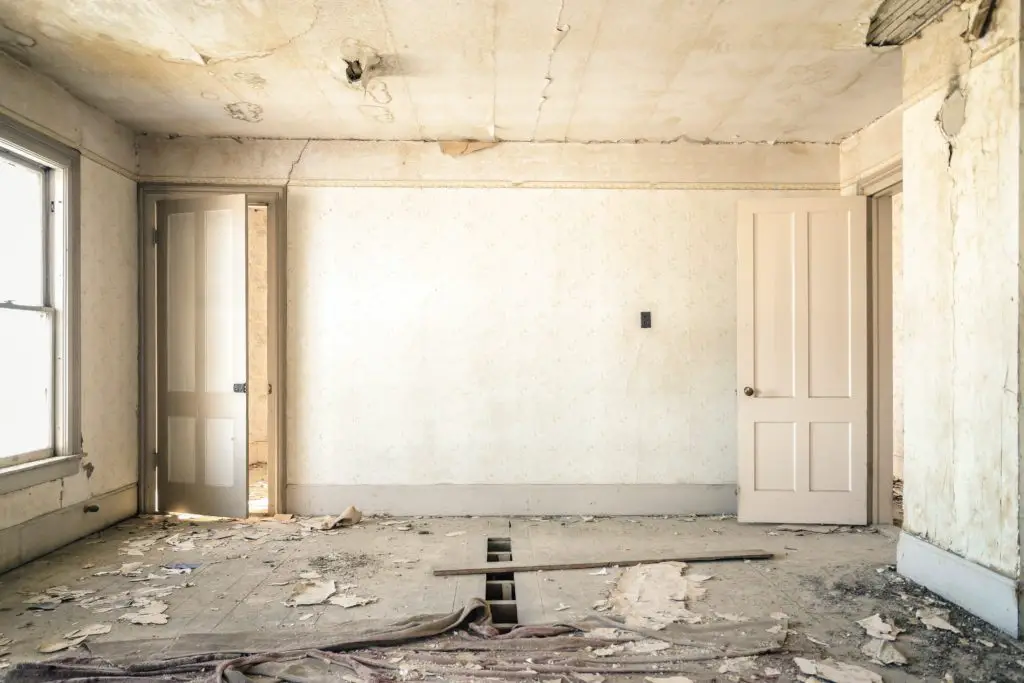
Gutting your house is a methodical process. Don’t just throw yourself into it. Do not rush into buying a rubbish skip either. They can be expensive and you may need that extra money later in your renovation process.
Choosing where to put your rubbish as well, before you throw it out is an important consideration too, as it can become a bit of an obstruction.
That being said, this is my suggested approach to gutting your house;
- Go into each room and make your own rough assessment about how much rubbish you’re going to have and the type of rubbish, i.e carpet, rubble (e.g. ceramic tiles), and make a list. Categorize it by heaviest and/or largest items as well (I’ll explain later)
- Choose an area or room (e.g an empty garage) to store your rubbish bags as you clear it.
- Start clearing your house by ordered category, and stack close to a door, where you can easily load into a car.
- Once you have cleared a specified category, Take the rubbish to your local waste disposal center, and then start on the next one.
By taking this approach, not only will you clear your rubbish quicker, but you’ll be able to dispose of the majority of your rubbish for free. You think it’s a relatively small saving, but trust me you’ll need every penny as unexpected costs can arise at any given moment in a renovation project.
2. Get the electrician in to do any necessary re-wiring

Electricians tear into walls and ceilings to run cabling for your plug sockets, electric cookers, lights and light switches. It’s better to get your wiring assessed and sorted out before you do any other job.
When I was renovating my home, my electrician pointed out to me that my house ran on a single circuit across my whole house, and because of the old wiring, I was unable to to have a two way light switch at the top and bottom of my stairs.
For advice on plug socket placement and wiring, here’s an article that I’ve written detailing things to consider.
When you call your electrician, these are the jobs you want to consider having done in my opinion:
- Changing your fuse box (ask your electrician if your current box is up to current standards)
- Plug socket placement (Article mentioned above)
- Installing an extractor fan in your bathroom (More information on considerations in our article here)
- Light switches and wiring (If you’re thinking of using dimmer switches, 2-way switches, specific lights, its the time to ask if your current wiring is sufficient)
- Outdoor plug sockets (get them installed)
- Wiring for electric showers & radiators, and boilers
It pays to think ahead in my opinion, think about where you want to put your TV, where you want to position your sofas, basically how you are going to use the house. This forward-thinking can help you to decide where to put light switches and plug sockets.
The boiler is a big one too. If you are thinking about moving your boiler, get the nesessary electrics sorted out in the room that you want to move your boiler too.
All of these points will help you get the most from your experience with your electrician, and hopefully prevent any roadblocks in renovating your house.
3. Get the plumber in to change boilers & replace radiators if necessary

Plumbers are just as important as electricians, and once your electrician has been, it’s a good time to get your pipework sorted out.
The jobs you should ask your plumber about include the following:
- Plumbing connections for appliances such as washing machines, and fridges with water dispensers
- Gas lines from kitchen hobs if necessary
- Placement of radiators. Now is the time to move them
- Plumbing connections for electric shower choices, bathtubs, and sinks
- Outdoor tap plumbing
It’s a good time to ask about all of these jobs.There are some jobs you may want to ask the plumber to leave ‘half done’. This includes fitting radiators.
Whilst he should do the necessary pipework and install the connections, it may be worth asking him to hang the radiators after you have finished decorating.
It may cost you extra, but you will save time when it comes to obstructions when stripping wallpaper and plastering for example. Just something to think about anyway.
Again, with plumber think ahead. Think about the placement of items, the type of radiator, sink and shower fixtures. The more questions you ask about suitable items, the less issues you will ultimately face.
4. Remove Wallpaper

Once you have gutted your house and got your plumbing and electrics sorted, it’s time to remove the existing wallpaper.
By this time some of the work should have been done for you depending on how much the electricians and plumber has dug into your walls.
It’s worth removing the wallpaper yourself, as some builders charge more to remove wallpaper prior to plastering. It’s not too difficult and this job only requires some elbow grease.
So get your friends involved and get the job done. If you are planning on re-wallpapering, make sure the walls are as clean and smooth as possible. It means you’ll have a better finish.
When it comes to wallpapering in general, there are some points I’ve mentioned in a post on wallpapering over old wallpaper (which could be an option, in this case, to be fair) that you may find useful.
5. Get Your Plastering & Skirting Done

Unless you have to skills to be a plasterer, now is the time to get the builder in to start making your house look pretty.
Provided that you’ve got your other jobs done correctly and addressed all of your plumbing and electrical needs, this part should go smoothly.
At this point, it’s worth builder about how much he charges to do the coving (if desired) and skirting. If expensive, or if your budget is tight, these jobs are very doable by yourself.
If the walls are in good shape and smooth, consider hanging lining paper rather than re-plastering. It can literally save you thousands and the finish can be just as good. The best part is you can do this job yourself as well if you want to.
Here’s a guide I wrote on choosing and fitting coving to help you on your way.
If you are thinking of having laminate or hardwood flooring in any of your rooms, it may be worth asking your builder to fit the skirting boards after you’ve finished painting.
The finish is much better whether you have skirting boards fitting directly over wooden flooring, without the need for beading. There’s more detail on this post regarding choosing skirting or beading.
Going back to plastering, If you’re looking at getting a professional in to do the wallpapering, you are better off getting your walls re-skimmed if you are planning to paint as prices tend to be similar, and skimmed walls tend to look sharper.
6. Get the Tiling Done in the Kitchen and Bathroom
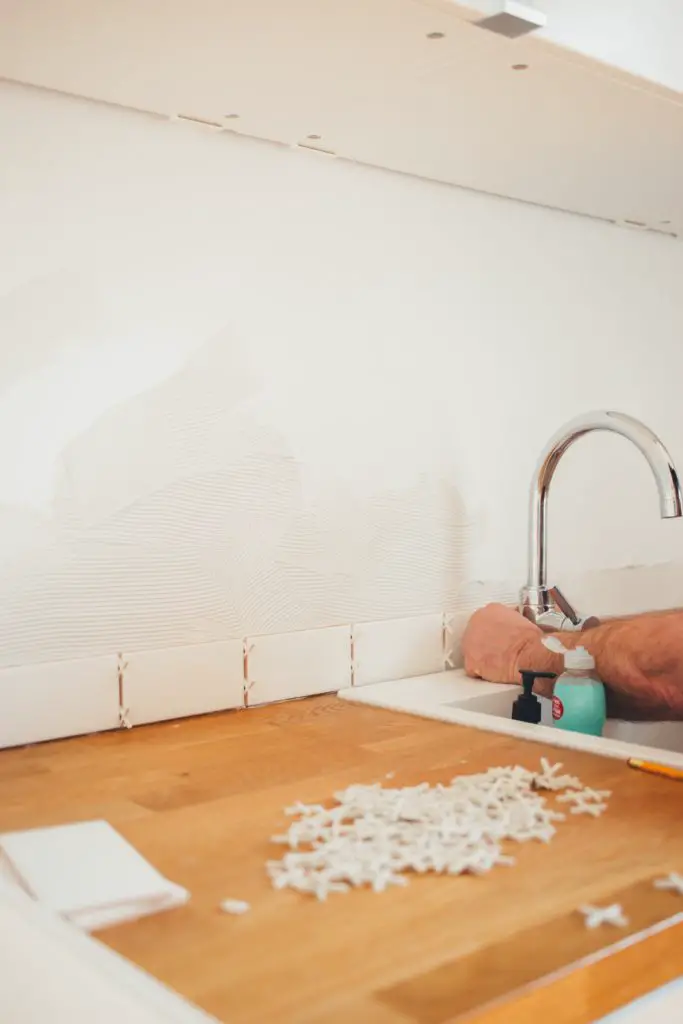
The tiling in your kitchen and bathroom are jobs that you should get done now. The reason being is they can be messy jobs, but they are also delicate. You want to fit the tiles, get the grouting in, and give it sufficient time (at least three days) before you start fitting your kitchen or bathroom.
Key considerations when you are choosing tiles for a bathroom or kitchen include the following:
- The spacing between tiles
- The color of the tiles in line with the. If your room is small, pastel colors tend to make it look bigger
- The color of the grout. This is often overlooked but can ruin the look and feel of your bathroom or kitchen if not chosen correctly. Make sure it matches the tile in question.
7. Bathroom and Kitchen Fitting
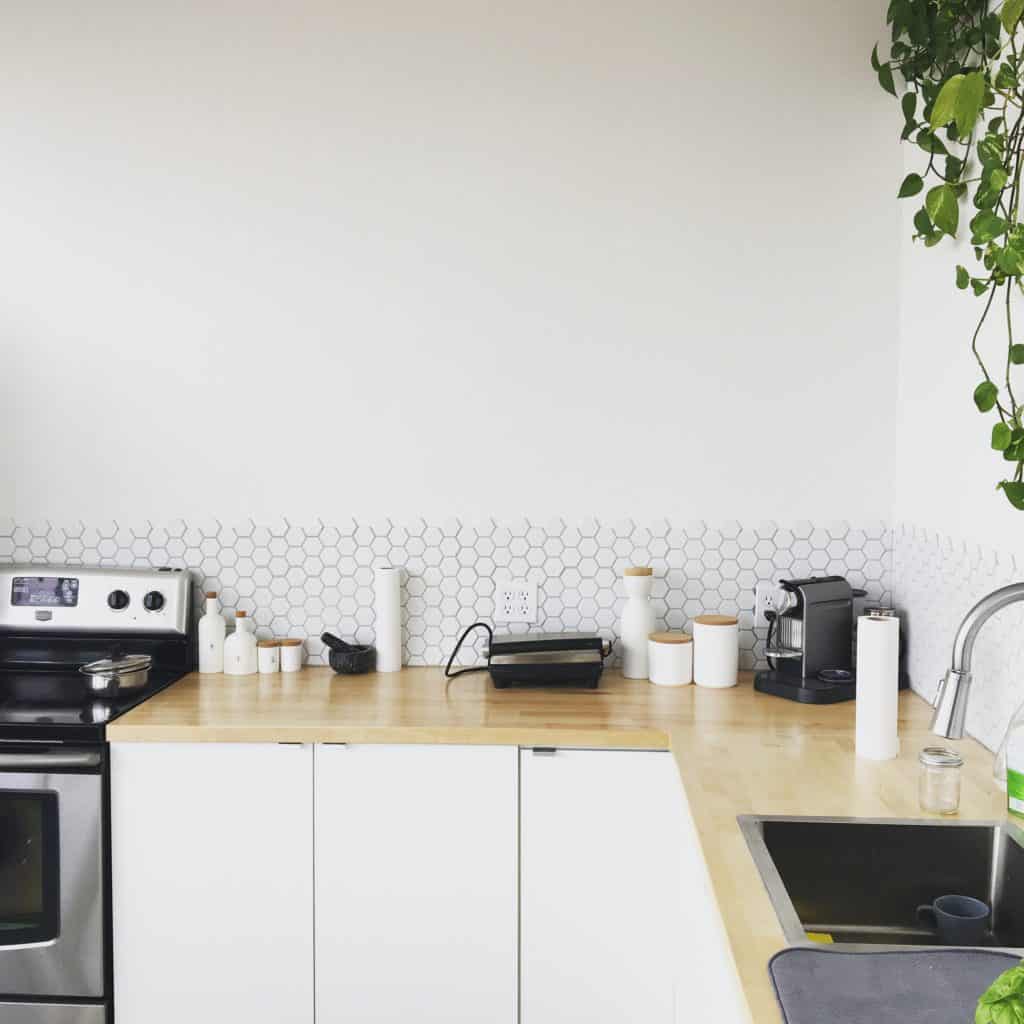
Getting your Bathroom and Kitchen fitted is when you can start to see the light at the end of the tunnel, i.e jobs start to get easier once this step is done and you can see the finish line.
It’s a good time to get these jobs done now as you’ve got the plumbing and wiring infrastructure in place to get your kitchen and bathroom installed.
When you are choosing an electrician, handyman or plumber, get multiple quotes too. Prices swing like crazy. I ask people for recommended people as well as using sites like Ratedpeople.com.
Ask people wherever you go. I found my kitchen fitter/ plasterer and builder through a conversation with a sales person in a kitchen showroom.
8. Painting & Decorating
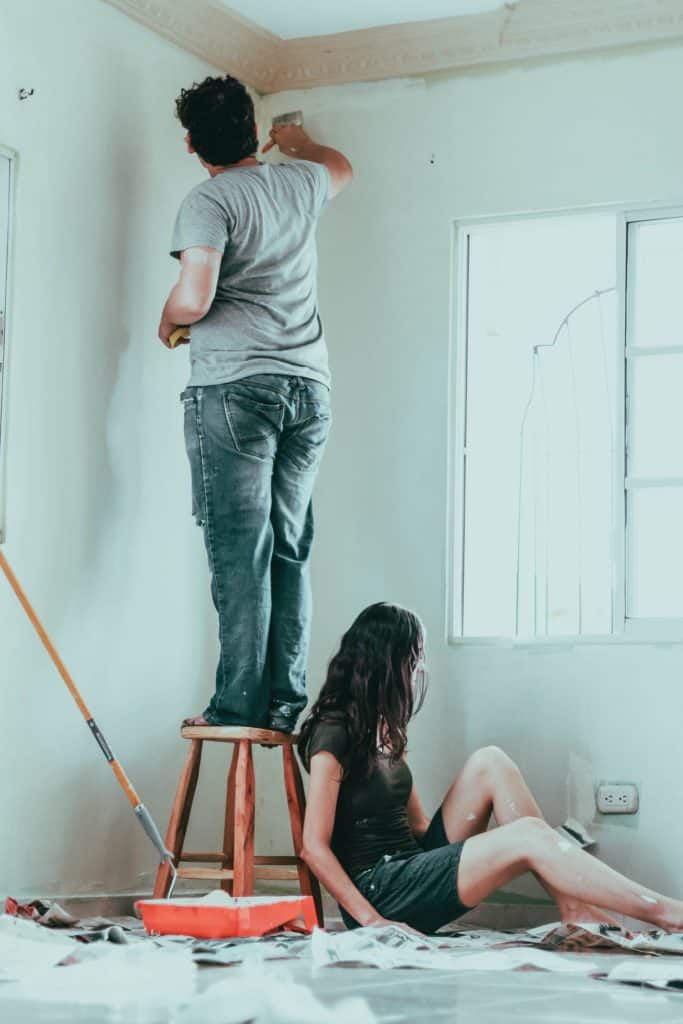
Painting and decorating is the fun part of any renovation project. If you’re not too drained from all of the activities undertaken in the previous steps, you should really get stuck into this one.
As mentioned in our wallpaper article, it’s best to decorate top down. By this we mean:
- Painting the ceiling and coving first (2 – 3 coats – wait for 2-3 hours between each coat)
- then move on to the walls (2 – 3 coats – wait for 2-3 hours between each coat)
- Ending with the skirting and door trims (2 coats including primer – wait for 2-3 hours between each coat)
- Any other woodwork (woodwork is super messy so make sure everything is dry before you sand and paint)
Decorating top-down is generally the quickest and most efficient way of painting mainly because you cover the larger areas first, which don’t require as much attention to detail.
Its also because if you’re intending on using a roller to paint your walls, it’s easier to clean up and cover up any spattered paint on the skirting boards before you paint them rather than after.
Be sure to use frog tape in between sections in order to get clean lines too.
When it comes to painting woodwork, preparing & painting it last is the best way to ensure sawdust particles don’t get stuck to your ceiling, walls or skirting board before you paint it.
If you are planning on fitting your skirting after your laminate or hardwood flooring, I would also hold off on preparing and paint woodwork until that’s done as well.
9. Carpets and flooring
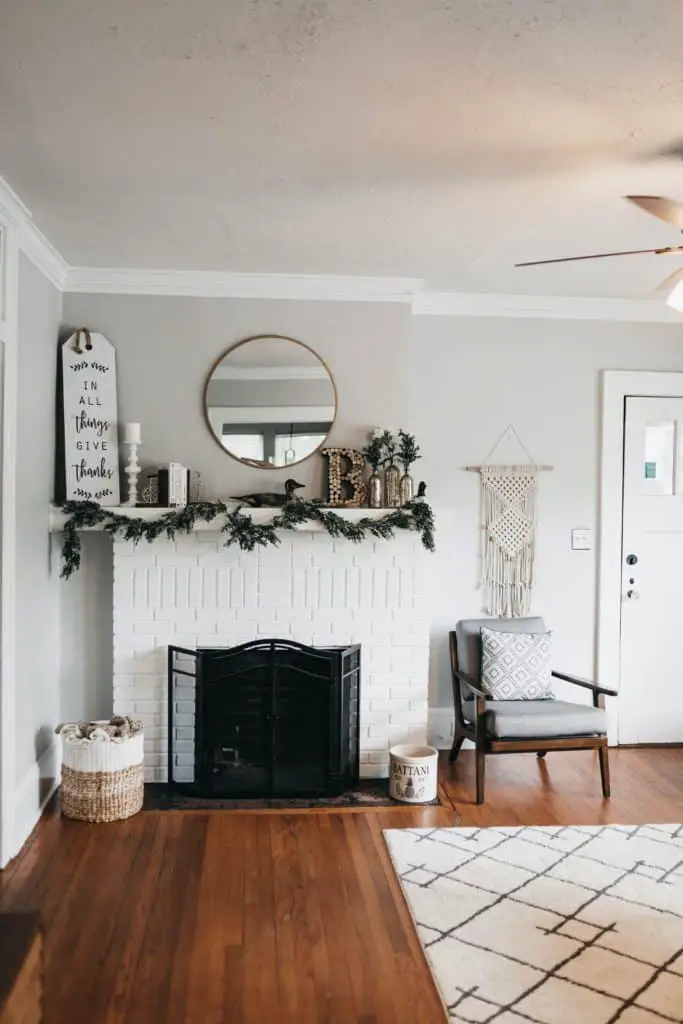
Now all the hard work is done. Before you rush to the flooring shops, there’s a few things you need to check.
- Make sure all the floorboards are nailed down or screwed in. The last thing you want is loose floorboards under your flooring or carpets
- Make sure no nails are sticking out of the floorboards, just generally
- rip out any old carpet grippers, it’s best to have these replaced if you’re changing your carpets and usually not too pricey
- Give the floor a clean and pry up any plaster stuck to the floorboards along with anything that will make your flooring look uneven.
You’re ready to have your flooring fitted. If you have been through all of these steps, well done, I bet your house looks great, It’s time to pick out furniture!
Tips on picking out furniture
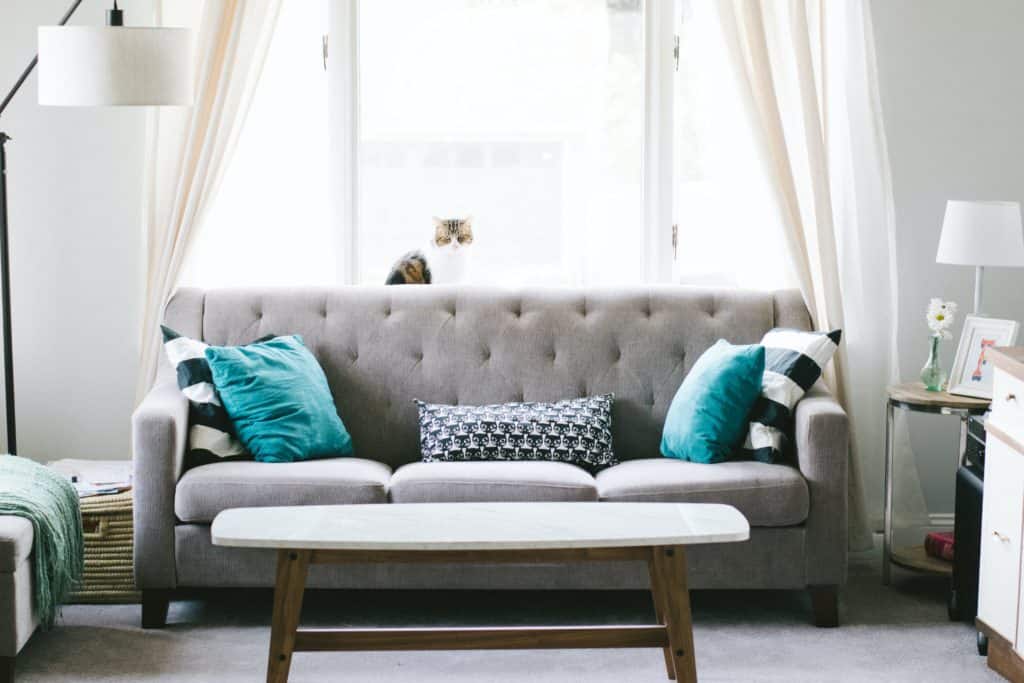
When it comes to picking out furniture, againt it’s important not to rush. If you’re living in the home that you are renovating, don;t rush to buy wardrobes and sideboards and beds.
Moving into a new place is a great chance to take stock of everything you actually need. So throw things out, and then decide on your wardrobe.
if your budget is strained at this point given the amount of work that you’ve just done, IKEA is a fantastic place to buy durable furniture as long you build them right. In this post I have some examples of IKEA furniture I have bought myself.
Related Questions
Is it smart to renovate your house?
It all comes down to the numbers, but generally speaking, if you can get a place that is structurally sound but at significantly lower (15%-20%) lower than the market price, I would say yes. The more DIY effort you put in as well, the more you benefit of your mortgage and re-sale.
How can I renovate my house cheaply?
Renovation does not have to be an expensive job. Take a methodical approach to clearing and doing up your house. Understand which jobs are the most expensive and look at alternatives. For example plastering or skimming is significantly more expensive than wallpapering (especially when you do it yourself).
Speak frankly to multiple electricians, plumbers, and people from that profession to help you form an opinion of what you want to do.
Which room should you renovate first?
It’s not advisable to renovate room by room. It will make your whole renovation process longer. Instead break up your renovation activities into stages including clearing out, electrics, plumbing, stripping wallpaper, and painting.
How much does it cost to fully renovate a house?
On average in the UK it costs around £15000-£20,000 to fully renovate an average 2-3 bedroom home, however, this is if you use a contracted builder to carry out all of the works, including re-plastering, a new kitchen, a new bathroom as well as carpets and flooring. If you carry out some of the work yourself you can reduce your bill by roughly £5,000-£6000.
In Summary…
Renovating a house is not an easy job, but doing things in the right order and taking a logical approach can really help you get through the process quicker and more efficiently.
The most important thing is not to rush your approach a renovation job. Before you begin, take a look at what you’re dealing with and really understand what jobs need tobe done.
It’s also super important to be as frugile as you can especially in the initial stages of any renovation job, as you will probably need teh money later down the line. Renovation jobs always come with unexpected surprises.
The approach mentioned in this article is from my personal experience of renovating homes and making mistakes.

